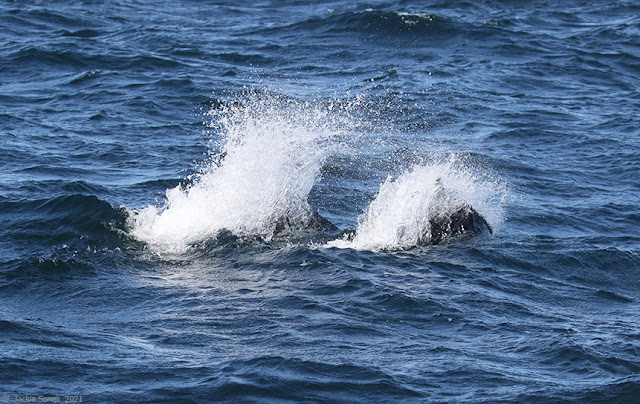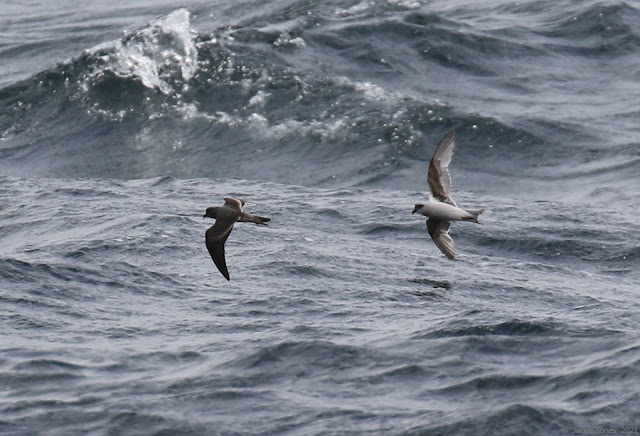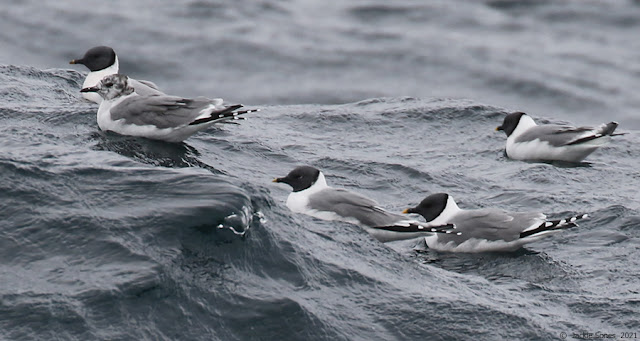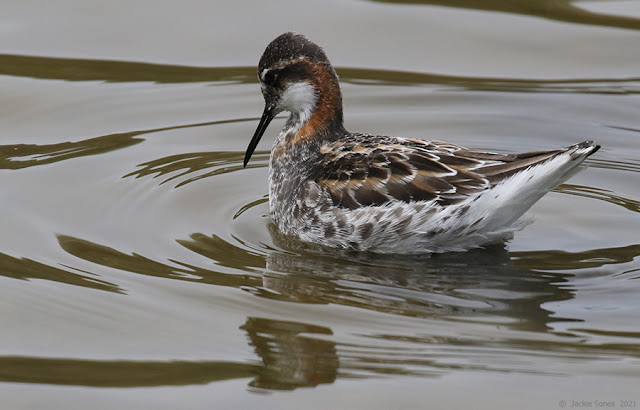Monday, May 31, 2021
Leaning forward
Sunday, May 30, 2021
Side by side
Two species of storm-petrels — Ashy Storm-Petrel (Oceanodroma homochroa) on the left and a Fork-tailed Storm-Petrel (Oceanodroma furcata) on the right.
We didn't see many storm-petrels during the boat trip on 23 May 2021, but here's a fun silhouette view of two Fork-tailed Storm-Petrels:
Saturday, May 29, 2021
Gliding and arcing
Black-footed Albatross (Phoebastria nigripes) were in view for most of the day during the pelagic trip on 23 May 2021. Sometimes they were in the distance, other times very close to the boat, often there were more than 15 in view at one time. Here are a few different perspectives:
Friday, May 28, 2021
On and over the waves
We encountered a few nice flocks of Sabine's Gulls (Xema sabini) during the pelagic trip to Bodega Canyon and beyond on 23 May 2021.
Here are a few shots on the water, and a few shots in flight. Be sure to look for the nice black edge to the dark gray hood, and the yellow tip on the bill. Some birds haven't molted into breeding plumage yet, so have smudgy gray heads and dark bills. [You can click on the images for larger versions.]
Thursday, May 27, 2021
Jaeger silhouettes
A few Parasitic Jaeger (Stercorarius parasiticus) shots from the offshore boat trip on 23 May 2021.
Jaegers are impressive aerialists — they're kleptoparasites, chasing other birds like terns and gulls to force them to drop their fish.
The lighting was a little tough, dark birds against an overcast sky, but I love their silhouettes. Enjoy! [You can click on the images for larger versions.]
Wednesday, May 26, 2021
Early morning bonus
This morning we had to get up at ~4 a.m. for low tide field work, but what a bonus that there was a lunar eclipse at that time! Here's a quick shot from Cotati at a little after 4 a.m., just before the eclipse reached its maximum.
P.S. Pelagic week will continue tomorrow!
Tuesday, May 25, 2021
With aloha
Another special bird from our offshore pelagic trip on 23 May 2021. This one is a Hawaiian Petrel (Pterodroma sandwichensis).
Hawaiian Petrels, or 'Ua'u in Hawaiian, nest in burrows along the slopes of volcanoes in Hawaii. They spend most of their time in the tropics (below 20°), but after the breeding season, some disperse northward to higher latitudes when we have a chance to see them offshore.
The genus "Pterodroma" means "fast flyer" or "wings for racing," an appropriate name for this group of seabirds that seem to rocket by, arcing above and below the horizon. The photo above was taken by Dan Nelson, who managed a wonderful picture given the distance and speed of this bird. I didn't get a close-up, but here's one I like, showing a Hawaiian Petrel in its open ocean habitat:
P.S. Many thanks to Dan for sharing his wonderful photo!
Monday, May 24, 2021
Murphy's, Part 2
Here are a few more photos of the Murphy's Petrel (Pterodroma ultima) observed ~30 miles offshore yesterday (24 May 2021). This species nests in the south-central Pacific Ocean (e.g., Pitcairn Islands, Tuamotu Islands, Austral Islands) and then shifts north to the subtropical areas of the NE Pacific during the non-breeding season. They're visitors to offshore waters as far north as British Columbia.
According to the Rare Birds of California, Murphy's Petrel is a routine visitor to California, but generally occurs "offshore near the interface between warm waters of the North Pacific Gyre and cold waters of the California Current."
Note the overall dark gray coloration, paler color around the face (especially chin/throat area), and extensive white on underside of the primaries (outer wing feathers).
Sunday, May 23, 2021
Ultima!
I joined an offshore pelagic trip today (23 May 2021), going out beyond Bodega Canyon and crossing Cordell Bank. It was breezy (!), but we were rewarded with an amazing sighting of Murphy's Petrel (Pterodroma ultima) — a life bird for many people on the boat, including me. There were some other very nice sightings, so I'll be sharing some views of our offshore neighbors this week. Stay tuned!
Thursday, May 20, 2021
Waiting out the wind
Well, when it comes to phalaropes, I just can't help myself. I caught up with a few more Red-necked Phalaropes (Phalaropus lobatus) in the early evening (20 May 2021). So here's another selection of these beautiful sea-shorebirds that spend nine months out of the year at sea, but that we're lucky to observe at the coast every now and then.
Hunkered down in the wind:
Wednesday, May 19, 2021
Stopping by on the way to the Arctic
Tuesday, May 18, 2021
Knot variations
Feather details and variations:


















































